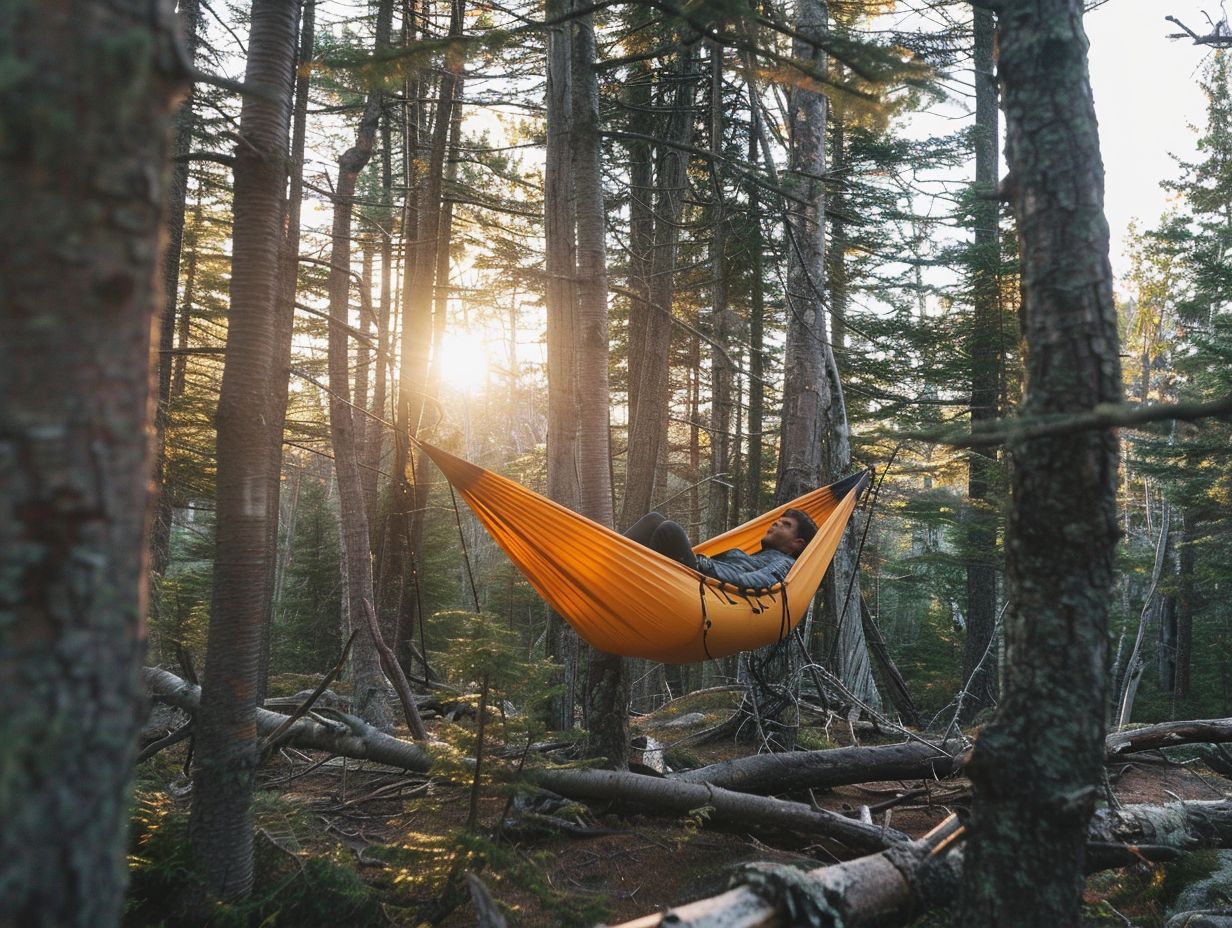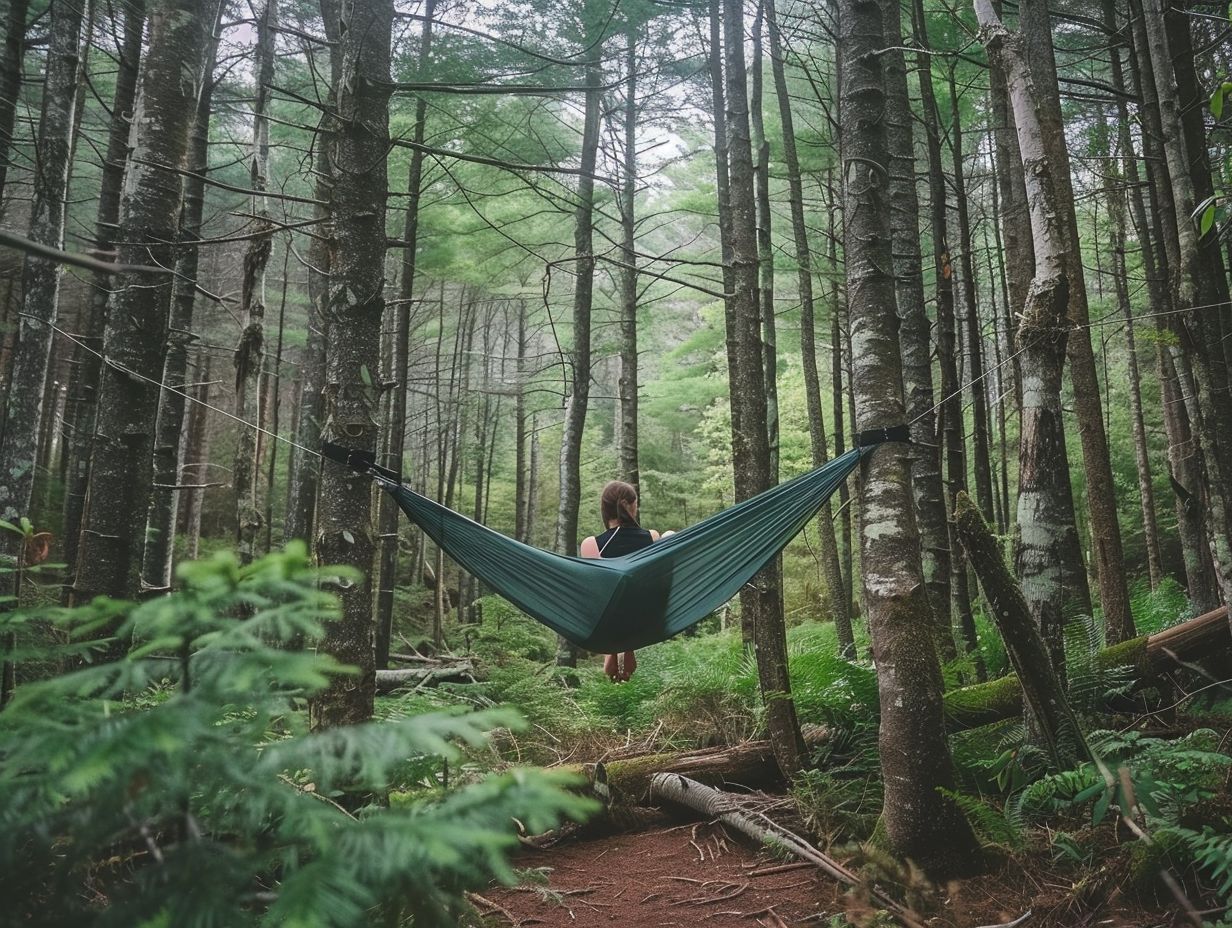Looking to take your camping experience to the next level? Hammock camping might just be the answer you’re looking for. We explore why choosing a hammock for camping can be a game-changer, comparing it to traditional tent camping.
We discuss what you need for setting up a camping hammock, provide step-by-step instructions on how to set it up, and share some valuable tips for making the most out of your hammock camping experience. So, grab your gear and let’s get started!
Key Takeaways:

- A hammock can be a comfortable and convenient alternative to a traditional tent for camping.
- The key items needed for setting up a camping hammock include a hammock, suspension system, straps or rope, carabiners, tarp, and bug net.
- To properly set up a camping hammock, you need to find a suitable location, hang the hammock, attach the tarp, and set up the bug net (if needed).
How to Set Up a Camping Hammock?
Setting up a camping hammock requires completing several essential steps to ensure its secure and comfortable suspension, thus creating a stable and safe sleeping environment amid the natural surroundings.
1. Find a Suitable Location
Selecting an appropriate location for the setup of a hammock requires the careful selection of two sturdy and healthy trees, spaced at an adequate distance apart. It is imperative to ensure that the chosen trees have the capacity to support the weight of the hammock and serve as a reliable anchor.
Criteria for tree selection should include robust trunk structures and branches devoid of any signs of disease or structural weakness. Before proceeding with the installation of the hammock, a thorough assessment of ground conditions is recommended to mitigate potential risks, such as uneven terrain or nearby obstructions.
Ideally, the recommended distance between the two trees should fall within the range of 12-15 feet to ensure a comfortable and secure hammock experience.
2. Hang the Hammock
Properly setting up the hammock requires attaching the suspension system to the trees and adjusting the angle of the hammock to ensure a comfortable position.
To secure the hammock to the suspension system, begin by wrapping the straps around the trees, ensuring they are firmly in place and level. After securing the straps, attach the hammock carabiners to the loops at each end of the straps. To modify the height, adjust the straps along the trees until the desired tension level is achieved.
Establishing the correct hammock angle is essential for both comfort and stability. It is recommended to aim for a 30-degree angle to strike a balance between relaxation and support. When dealing with trees that are spaced further apart, extend the straps accordingly to accommodate the distance while maintaining the appropriate hammock angle.
3. Attach the Tarp
It is imperative to attach the tarp over the hammock to provide protection from inclement weather, thereby establishing a secure and comfortable shelter.
To properly affix the tarp, initiate by fastening one end of the tarp above the hammock using a ridgeline secured between two trees. Ensure the tarp is angled to facilitate the drainage of rainwater. Employ guy lines and stakes to secure the remaining corners of the tarp, adjusting the tension to prevent any sagging.
For repositioning the tarp, simply relocate the guy lines and stakes accordingly. During windy conditions, it is advisable to lower one side of the tarp closer to the ground for enhanced protection. It is essential to periodically inspect the tension and make necessary adjustments to sustain optimal coverage and protection.
4. Set Up the Bug Net (if needed)

In areas prone to insects, it is crucial to set up a bug net to facilitate a comfortable and uninterrupted rest in your hammock. To effectively install a bug net around your hammock, it is advisable to start by selecting a bug net that is compatible with the hammock’s dimensions and configuration.
It is imperative that the bug net is sufficiently large to provide complete coverage while also allowing for adequate airflow. After acquiring the suitable bug net, it is essential to delicately position it over the hammock, ensuring that it completely encloses the sleeping area.
Fasten the bug net securely to the hammock straps or ridgeline to prevent any gaps through which insects may infiltrate. Regularly inspect and readjust the bug net to uphold its efficacy and ensure a bug-free experience during outdoor expeditions.
What Are Some Tips for Using a Camping Hammock?
Effectively utilising a camping hammock necessitates adherence to various guidelines to guarantee a secure installation, restful sleep, and a pleasant camping experience overall.
1. Use a Sleeping Pad or Underquilt
Utilising a sleeping mat or underquilt is imperative for ensuring warmth and comfort during overnight stays in a hammock.
Sleeping mats are a commonly favoured choice for providing insulation, as they furnish a cushioning layer between the sleeper’s body and the hammock, while also furnishing a degree of protection from cold temperatures underneath. In contrast, underquilts are suspended beneath the hammock, serving as a shield against heat loss to the ground.
When deliberating on the appropriate insulation, it is advisable to factor in the anticipated weather conditions. Thicker underquilts or sleeping mats are more suitable for colder climates, whereas lighter alternatives may suffice in milder environments.
Before embarking on a camping excursion, it is recommended to assess the efficacy of the insulation setup to ensure a tranquil and comfortable night’s rest.
2. Bring Extra Rope or Straps
The inclusion of additional rope or straps can prove to be highly advantageous for adjusting the setup of one’s hammock or securing additional gear.
The possession of extra rope enhances the adaptability of one’s outdoor excursions. Whether the necessity arises to elongate the reach of the suspension system to identify the ideal hanging location or fasten gear securely, the availability of excess rope offers a broader range of solutions.
The proper storage of additional rope or straps is paramount to prevent entanglement and ensure their readiness for application when required. It is advisable to consider utilising a resilient bag or container to maintain organization and safeguard the items from environmental elements. Regular inspection and maintenance of the rope are essential to guarantee its dependability in diverse scenarios.
3. Practice Setting Up Before Your Trip
It is essential to practise setting up your hammock before embarking on a camping trip to ensure a seamless and efficient setup in the field.
Taking the time to familiarise oneself with the hammock and the necessary accessories can prove invaluable by saving time and reducing frustration at the campsite.
Conducting practice setups in a controlled environment allows for the identification of any potential issues, enabling proactive solutions. It is advisable to pay attention to proper angles, secure attachments, and comfortable positioning during these practice sessions to guarantee a restful sleep during wilderness excursions.
Embracing the opportunity to hone one’s skills and technique in hammock setup ensures readiness and confidence for camping adventures when the time arrives.
4. Check for Safety Hazards
Inspecting for safety hazards is a critical procedure when establishing your hammock to guarantee a secure and hazard-free camping experience.
One prevalent safety concern to be cautious of is unstable trees to which the hammock is being connected. It is imperative to verify that the trees are in good health and possess the necessary strength to bear your weight.
Additionally, the ground should be scanned for sharp objects like rocks or branches that have the potential to damage the hammock or pose a risk of injury.
Weather-related dangers, such as sudden wind gusts or storms, must also be taken into account. Consistent safety evaluations throughout your camping excursion can aid in averting accidents and ensuring a serene outdoor sojourn.
5. Use a Ridgeline for Hanging Gear
Using a ridgeline can offer a practical method for suspending gear and keeping essential items accessible while lounging in a hammock.
Properly establishing a ridgeline creates a versatile storage solution that enhances the efficiency of camping endeavors. Various objects such as lanterns, water bottles, or small bags can be suspended from the ridgeline using carabiners or S-hooks.
It is imperative to evenly distribute weight along the ridgeline to maintain equilibrium and prevent sagging. To uphold stability and ensure comfort during hammock relaxation, refrain from overburdening the ridgeline.
Regularly inspect the tension and stability of the ridgeline to preempt any untoward incidents and facilitate a seamless camping experience.
Frequently Asked Questions

How do I choose the right hammock for camping?
When choosing a camping hammock, consider the weight limit, length, and material. Look for hammocks specifically designed for camping, as they are more durable and lightweight. Consider whether you want a single or double hammock and if you want additional features such as bug nets or rain flies.
What type of trees are best for setting up a camping hammock?
Look for sturdy, healthy trees with a diameter of at least 4-6 inches. Avoid trees with branches that are too low or too high, as this can make it difficult to get in and out of the hammock. Also, be mindful of protected trees and avoid damaging them.
How do I set up a camping hammock without trees?
If you are unable to find suitable trees, you can use alternative methods such as using hammock stands or using anchors and straps designed for hammocks. Just make sure to follow the manufacturer’s instructions carefully for proper setup and safety.
What should I consider when choosing a hammock campsite?
When choosing a campsite for your hammock, look for flat ground, sufficient distance from hazards such as water or steep drop-offs, and enough space for your hammock to hang without touching the ground. Also, consider the direction of the wind and sun to ensure a comfortable and safe setup.
How do I properly hang a camping hammock?
To hang a camping hammock, wrap the straps or ropes around the tree at least 5-6 feet off the ground. Make sure the straps are at a 30-degree angle from the tree, and the hammock is hung tightly. Test the hammock’s stability before getting in, and adjust as needed.
What are some safety precautions to take when setting up a camping hammock?
Always follow the manufacturer’s instructions for setup and weight limits. Do not hang your hammock higher than 18 inches off the ground, and never hang it over rocks, water, or other hazards. Make sure to inspect your hammock and straps for any wear and tear before each use, and always use a sleeping pad or underquilt for insulation.

